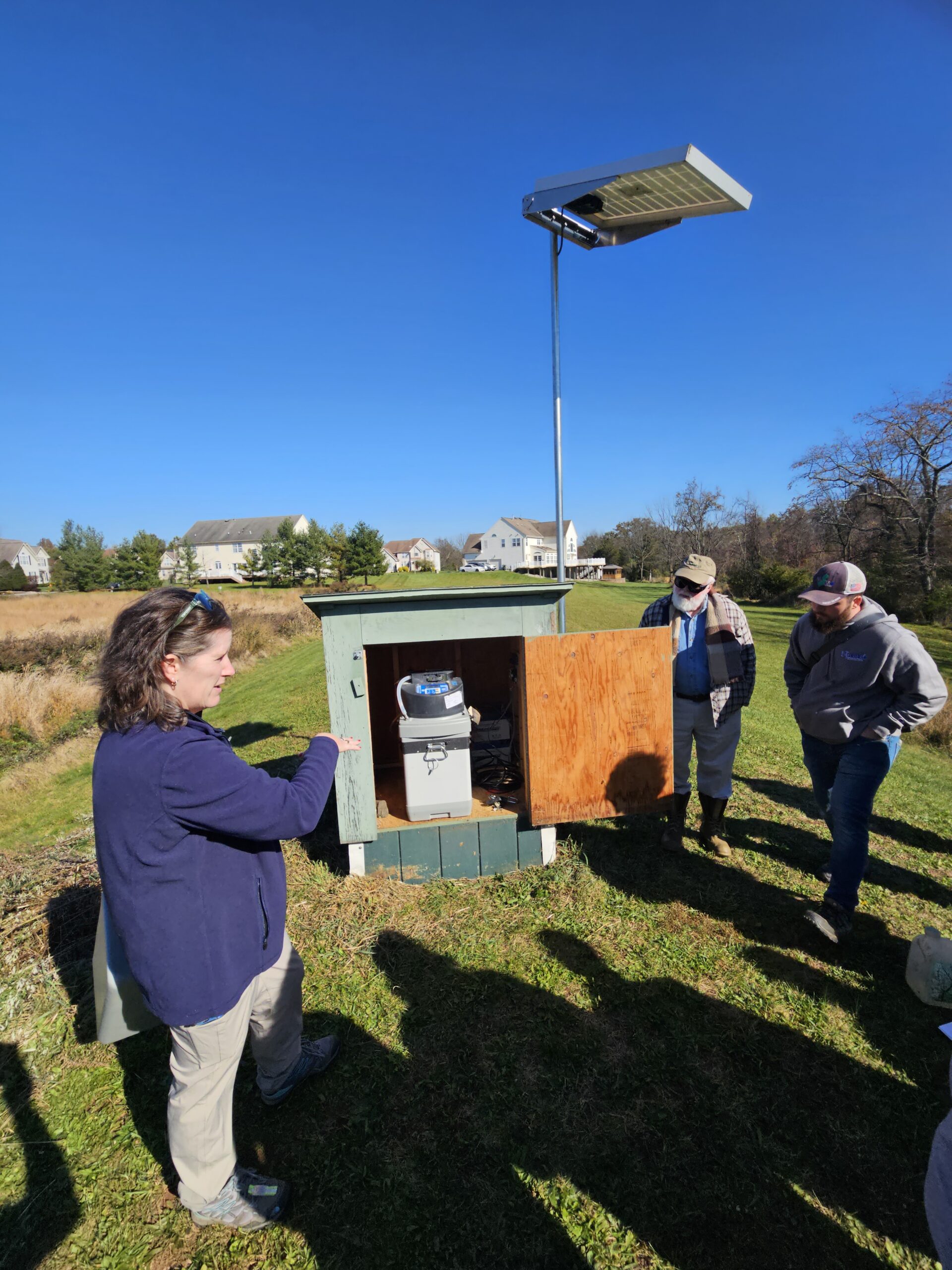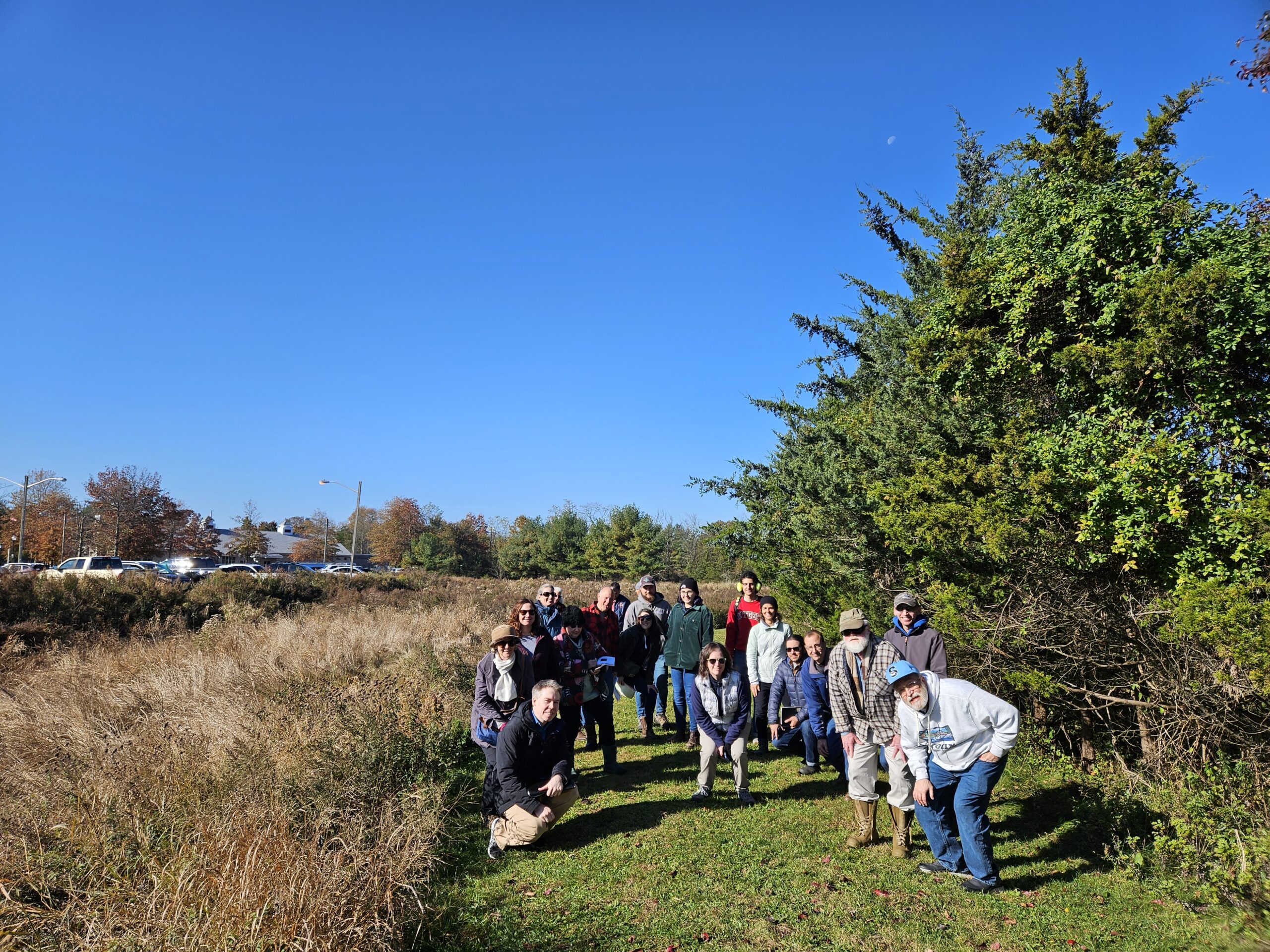Field Trip Report Back: Franklin Township Stormwater Basin Retrofits
Article by Franklin Township resident Anna Merrett, photos by LRWP Board Member Heather Fenyk and NJ Water’s Mitch Mickley. For tools and guidelines for implementing Green Infrastructure and low impact design in your communities, see the Environmental Protection Agency’s Non-Point Source Pollution webpage, which includes the Bioretention Design Handbook, published by their Nonpoint Source Management Branch. The handbook was developed to inform practitioners about the latest approaches and lessons learned for bioretention design, construction, inspection, and operation and maintenance.
On Friday, November 3rd, Kathy Hale, Principal Watershed Protection Specialist for NJ Water Supply Authority (NJWSA), led a field trip to four out of five retrofitted stormwater basins in Franklin Township, Somerset County. The outing was organized and sponsored by the Lower Raritan Watershed Partnership. Twenty participants, including members of municipalities, representatives from state departments, the Highlands Commission, engineering firms, academia and Environmental Stewards took part in the field trip. A smaller group ended the day with lunch at Stage House Tavern, where lively discussions followed.
Located in the Franklin Township Municipal Complex, on Gaugin Way, Renoir Way, Dellwood Lane and Laird Terrace, the stormwater basins are owned by the Township and mainly receive residential runoff. Franklin Township mapped their stormwater infrastructure ahead of most other municipalities. Township staff worked with NJWSA to select these five basins for retrofit based on size, location, visibility, and structure. The main goal of the retrofits is to slow water runoff and lengthen the water flow path, helping decrease the amount of sediment flowing into the Delaware and Raritan Canal and other local waterways. Increased sediment in stormwater runoff leads to the need for additional treatment by water supply purveyors.
Mitch Mickley, who shared this drone footage, shared that the drone was flown during a drought, and makes the stormwater basin at Renoir Way, Franklin Township (NJ) “look like a green oasis in a sea of dry dead lawns.”
NJWSA’s Kathy Hale explained the background for the basin retrofit in greater detail:
“NJ Water Supply Authority, created in 1981, is an independent state agency. Our main role is to manage water supply in Central New Jersey, so we manage Spruce Run Reservoir, Round Valley Reservoir and the Delaware and Raritan Canal as drinking water supplies that provide water to about 1.5 million people in Central New Jersey. We also manage Manasquan Reservoir, where we provide a supply for around 600,000 service connections in Monmouth County. NJWSA doesn’t treat water, but provides untreated water to the water purveyors, who then treat and distribute it. At Manasquan Reservoir we do have a small water treatment plant which provides water under contract to a few municipalities. Our main role is to maintain the quantity of water that flows to our water purveyors, including: NJ American Water Company, Middlesex Water, North Brunswick, New Brunswick and the municipalities in the Manasquan System. Our customers understand that it is less expensive to keep pollutants out of the water rather than remove them.
The Delaware and Raritan Canal is a 65-mile water supply facility that transfers water from the Delaware Basin to the Raritan Basin. Data and field observations show that turbidity does not decrease in the last 11 miles of the Delaware and Raritan Canal, indicating that settling solids are replaced by sediment from influent streams and stormwater discharges.
Traditional stormwater basins have a concrete low flow channel designed to move water through as fast as possible. Traditional stormwater basins are also typically planted with turf grass, which does not aid water quality treatment or drainage into the ground. Many stormwater basins are fairly compacted when it comes to the soil, which does not help with infiltration. The turf grass tends to encourage nuisance species such as geese and it has high maintenance cost.
We worked with the Township and identified several basins, which we prioritized, and chose four to be retrofitted. A fifth basin was added later in the project. Princeton Hydro provided design services for the project. Three of the basins are within the Cedar Grove Brook watershed, one of the largest drainage areas to the Canal. A fourth basin drains into Six Mile Run and the fifth basin drains into the Canal through another tributary. Funding for the project was provided by NJDEP and the Delaware and Raritan Canal Commission.”
Our group carpooled to the basins, where we walked around the basins, allowing for a closer examination of the retrofits.
Carl Hauck, the Manager of Franklin Township Public Works and the Township Stormwater Coordinator, explained the maintenance plans for the retrofitted basins: The township inspects the basins following every major storm, regularly checks for trash, removes sediment, and mows the basin meadow just once or twice a year. Previously, the basins were mowed every week during the high growth summer months.
Our group poses next to the stormwater basin at the Franklin Township Municipal Building
The new vegetation, consisting of native wildflowers, requires minimal upkeep, significantly lowering the overall maintenance cost, noise levels and energy usage. Planted wildflowers attract birds, pollinators, and other wildlife, and deter the geese. The upgraded vegetation with its deep roots, helps filter out pollutants and lets the stormwater runoff soak gradually and directly into the soil. The concrete channels for water runoff have been replaced by naturally meandering waterways, greatly slowing down the water flow. Berms, forebays and scour holes were built into the inlet structure to further slow down the runoff.
“At each of the basins, the bottoms were rototilled to reduce compaction and the soil was supplemented with compost. Basins are designed to drain within 72 hours, in part to prevent mosquito breeding.” At one of the basins, an underdrain was also added to facilitate water movement.
NJWSA reached out to the five stormwater basins’ neighbors holding zoom meetings and sending postcards explaining the necessity of the retrofit. Some homeowners did not find the look of the retrofitted basins visually appealing, preferring the traditional lawns.
NJWSA has conducted visual and vegetation monitoring. In addition, they are conducting pre and post construction water quality monitoring at two basins.

Kathy Hale explains how water quality samples are captured at this site.
Heather Fenyk notes: “The Lower Raritan Watershed Partnership offers multiple workshops and field trips annually to support municipalities and local community members to better understand local hydrology and best practices for watershed-friendly stormwater management. The November 3rd tour of Franklin Township’s retention basin retrofits was specifically organized as part of the LRWP’s MS4 Municipal Stormwater Management Assistance Program, through which we partner with municipalities to customize watershed-friendly stormwater outreach and education programs to help them meet federally mandated stormwater management requirements under the Clean Water Act. We invited Kathy Hale to share the wonderful work that Franklin Township and the Authority have done locally so that other municipalities in the area could get a soup-to-nuts understanding of what it takes to install these beautiful, watershed-friendly, River-friendly, drinking-water-friendly projects. We would love to see dozens of naturalized stormwater basins throughout the Lower Raritan!”

